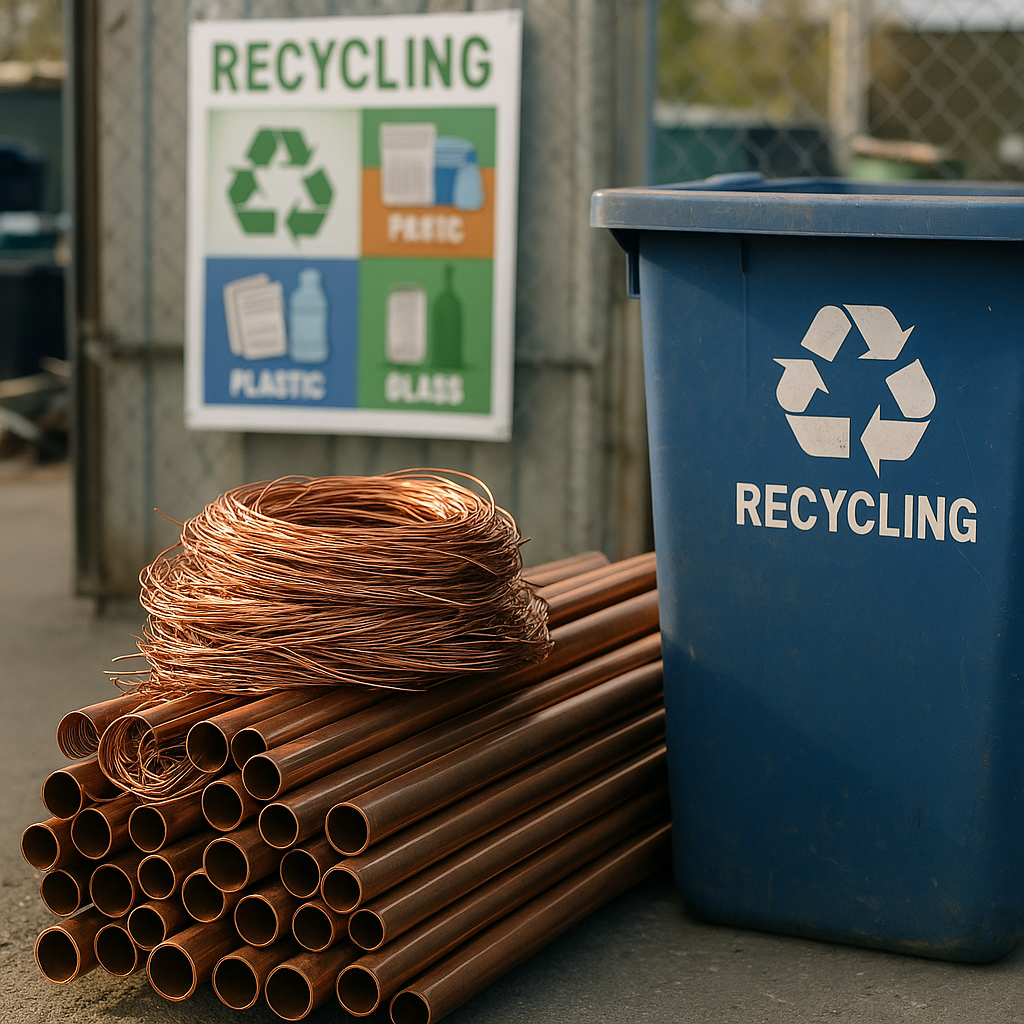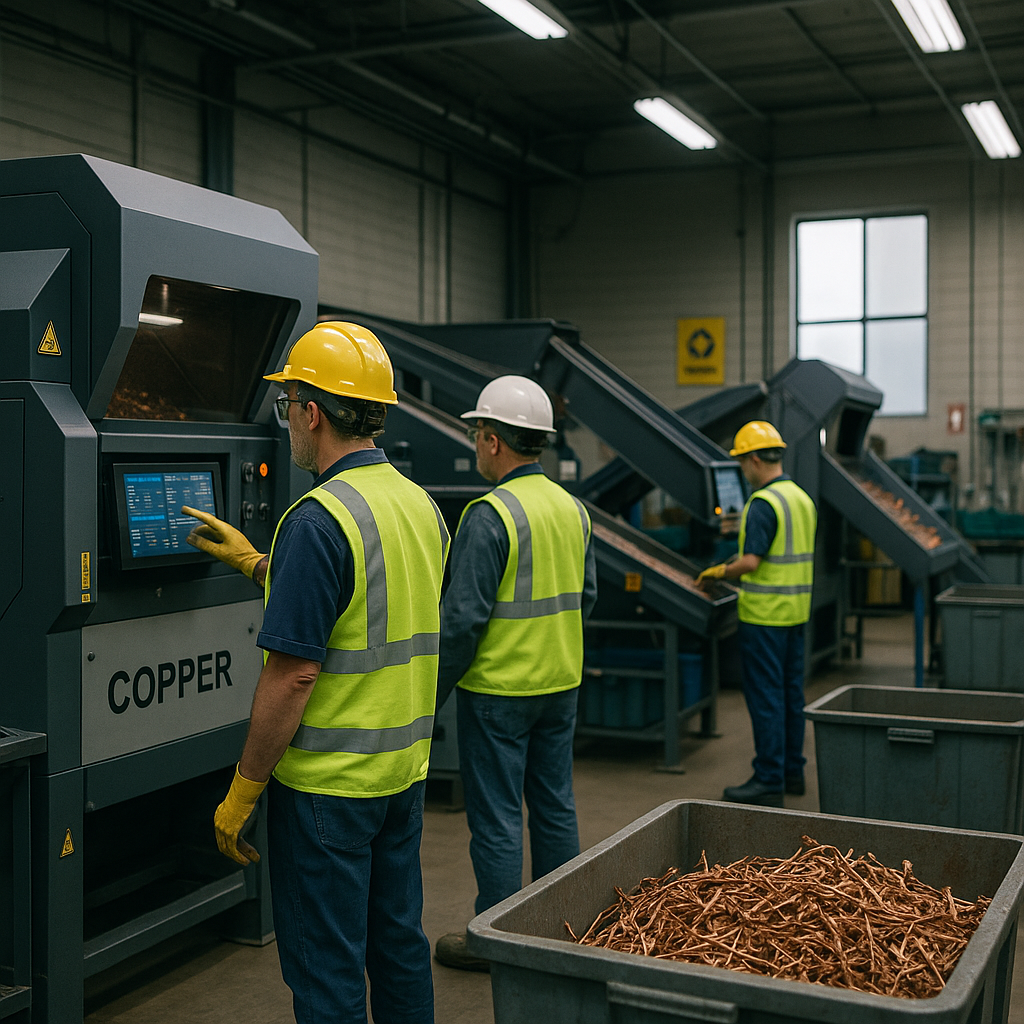5901 Botham Jean Blvd, Dallas, TX 75215
What Are Copper Recycling Awareness Programs?
June 5, 2025Did you know that copper can be recycled infinitely without any loss in quality? Copper recycling awareness programs are initiatives designed to educate communities on the importance of recycling copper and its environmental benefits. These campaigns highlight how copper, one of the world’s most versatile metals, plays a crucial role in creating a more sustainable future.
These programs focus on raising public awareness about copper’s exceptional recyclability. They provide information about proper collection methods, the recycling process, and how reclaimed copper returns to the manufacturing stream. Communities learn about copper’s vital role in sustainable resource management through workshops, educational materials, and public demonstrations.
The programs emphasize the significant environmental impact of recycling copper. When communities understand that recycling copper uses approximately 85% less energy than mining and processing new copper, they become more motivated to participate. These initiatives connect everyday actions to larger environmental goals like energy conservation, reduced carbon emissions, and waste reduction.
Why are Copper Recycling Awareness Programs Important?

Copper recycling awareness programs are crucial for building a sustainable future. These initiatives educate communities and industries about the environmental and economic benefits of reclaiming this valuable metal. Without proper awareness, copper often ends up in landfills despite being fully recyclable without quality loss.
Resource conservation is a primary benefit of these programs. The global demand for copper continues to rise in construction, electronics, and renewable energy sectors. Recycling reduces the need for mining operations that damage natural habitats and threaten biodiversity. Every ton of recycled copper prevents the disturbance of landscapes that would otherwise be excavated for ore.
Energy efficiency is another key advantage. Recycling copper requires up to 85% less energy than extracting and processing virgin copper. This significant difference results in reduced carbon emissions. Copper mining is energy-intensive, requiring substantial fossil fuel consumption for excavation, transportation, and processing.
The waste reduction impact of copper recycling awareness is significant. Copper has an indefinite lifespan when properly recycled. Programs that encourage the collection of copper from electronics, plumbing fixtures, and industrial equipment keep these materials within the circular economy. This closed-loop approach maximizes the lifespan of existing copper supplies.
Climate Change Mitigation
Copper recycling awareness programs contribute significantly to climate change mitigation efforts. The lower energy requirements of recycling directly reduce greenhouse gas emissions associated with copper production. Mining operations release carbon dioxide through fuel consumption and disturb carbon-sequestering ecosystems.
These programs also help local economies develop more sustainable industrial practices. By creating collection systems for copper scrap, communities can support recycling businesses that provide jobs while reducing environmental impact. The recycling industry creates approximately 30% more jobs than landfilling operations for the same amount of material.
Effective awareness initiatives highlight copper’s economic value in recycled form. Current scrap copper prices make recycling financially attractive for businesses and individuals alike. This economic incentive, when properly communicated, drives participation in recycling efforts.
Supporting the Circular Economy
Copper recycling awareness programs are essential for fostering a circular economy model. They shift public perception from viewing used copper as waste to recognizing it as a valuable resource. This mindset change is fundamental to increasing recycling rates.
The educational component of these programs helps individuals identify copper-containing products. Many consumers remain unaware that items like electrical wiring, plumbing fixtures, and electronic devices contain recoverable copper. Awareness programs teach proper sorting and disposal methods to maximize recycling potential.
These initiatives also connect industries to create more efficient recycling systems. Construction contractors, manufacturers, and utility providers all handle substantial amounts of copper. Awareness programs help these sectors implement better collection methods and find appropriate recycling partners.
Urban mining—the practice of recovering materials from urban waste streams—becomes more viable with increased awareness. Cities contain vast amounts of copper in buildings, infrastructure, and discarded products. Effective programs help communities tap into these resources instead of relying on new mining operations.
For businesses, awareness programs highlight compliance requirements and potential incentives. Many regions offer tax benefits for recycling activities while also imposing regulations against improper disposal. Understanding these factors drives corporate participation in copper recycling efforts.
The long-term success of copper recycling depends on continued public engagement and awareness. As technology advances and environmental concerns grow, these programs adapt to communicate new information and methods. They ensure that stakeholders across society understand both the individual and collective benefits of copper recycling.
How are Copper Recycling Awareness Programs Implemented?

Copper recycling awareness programs use various approaches to educate stakeholders and encourage participation, targeting audiences from individual community members to large industrial partners. The most effective campaigns combine multiple strategies to maximize impact.
Public Awareness Campaigns
Public awareness campaigns are central to copper recycling initiatives, using accessible messaging to highlight the environmental and economic benefits. Successful programs emphasize that recycling copper uses about 85% less energy than extracting it from virgin sources.
Media platforms play a crucial role in spreading information. Local newspapers, radio, television, and social media reach diverse audiences with tailored messages. The European Copper Institute has implemented initiatives across Europe to promote copper recycling awareness.
Campaign materials often feature eye-catching visuals demonstrating copper’s recyclability and importance in a circular economy. These campaigns connect the abstract concept of recycling to tangible benefits like energy savings and reduced environmental impact.
Educational Initiatives
Schools and community centers are ideal venues for educational initiatives about copper recycling, often including workshops, training sessions, and interactive demonstrations. The goal is to build awareness from an early age and foster a recycling culture.
Training sessions for businesses and employees are another crucial component, explaining the benefits of copper recycling and providing guidance on implementing effective collection systems. Employee education ensures recycling becomes part of daily operations.
Community workshops offer hands-on experience with copper recycling concepts, typically including demonstrations of sorting, processing, and reuse in manufacturing. These workshops help overcome knowledge barriers to recycling participation.
Efficient Collection Systems
Well-designed collection systems are the foundation of any copper recycling program. Designated collection points make recycling convenient, ensuring valuable copper doesn’t end up in general waste streams. For businesses, this might mean dedicated bins in manufacturing areas or centralized stations.
Successful programs use color-coded bins or containers for copper and other metals, with clear signage and instructions to help participants correctly sort recyclables. The easier the system, the higher the participation rates.
Regular pickup schedules or drop-off events create reliable routines that encourage participation. In industrial settings, partnerships with recycling centers can include scheduled collection services tailored to production volumes and timing.
Industry Partnerships
Partnerships between recycling centers, industries, and local authorities create synergies for copper recycling programs, often leading to innovations in collection methods, processing techniques, and public engagement strategies. Academic-industry partnerships drive innovation through research into more efficient extraction methods.
Government entities play a significant role through policy implementation, encouraging copper recycling with deposit and refund programs, tax exemptions, or subsidies for recycling initiatives. These incentives create financial motivation alongside environmental concerns.
Monitoring and tracking systems allow partners to measure program effectiveness. By reviewing the amount of copper recycled and associated cost savings, organizations can identify areas for improvement. Sharing these results with stakeholders helps maintain enthusiasm and support for recycling initiatives.
Program Assessment and Refinement
Successful programs include mechanisms for ongoing assessment and improvement. Regular evaluations help identify which approaches work well and which need modification, examining participation rates, copper volumes collected, and program costs.
Feedback from participants provides valuable insights for refinement. Surveys, focus groups, and suggestion systems help managers understand barriers to participation and opportunities for enhancement, ensuring programs remain relevant and effective.
Updating program materials and approaches based on assessments keeps campaigns fresh and engaging. Incorporating new information about recycling benefits or techniques into educational materials maintains accuracy and impact.
What are the Challenges in Copper Recycling Awareness?

Despite copper’s infinite recyclability and significant environmental benefits, several challenges impede effective recycling efforts. Public knowledge gaps remain a major barrier to improving copper recycling rates, with many individuals unaware of copper’s value and importance in modern infrastructure.
Limited Public Knowledge
Most consumers don’t recognize the copper components in everyday products. From wiring in household appliances to plumbing fixtures, copper is ubiquitous but often invisible to end-users. This knowledge gap means valuable copper frequently enters general waste streams instead of being properly recycled.
When people discard electronic devices, they rarely consider the valuable copper components inside. Small electronic items like mobile phones, which contain recoverable copper, often end up in landfills simply because users don’t understand their recycling value.
The economic and environmental benefits of copper recycling also remain largely unknown to the public. Many aren’t aware that recycling copper uses up to 85% less energy than mining and refining virgin copper, representing a missed opportunity for climate action through everyday choices.
Inadequate Collection Infrastructure
Even when awareness exists, insufficient collection systems create significant barriers. Many communities lack convenient drop-off locations for copper-containing products, making proper disposal inconvenient for residents and businesses alike.
Urban areas typically have more developed recycling infrastructure than rural regions, creating geographic disparities in access to copper recycling services. Some neighborhoods have no designated collection points, forcing environmentally conscious individuals to travel long distances to recycle properly.
The fragmented nature of collection systems also creates confusion. Different municipalities often have varying rules about what can be recycled and how materials should be prepared, leading to inconsistent participation across regions.
[[artifact_table]] Comparison of copper collection infrastructure challenges across different community types [[/artifact_table]]Ineffective Take-Back Systems
Many manufacturers have not implemented robust take-back programs for their copper-containing products. Without producer responsibility frameworks, the burden of proper disposal falls entirely on consumers, who may lack the knowledge or motivation to seek out recycling options.
Current take-back systems often suffer from poor design and limited accessibility. Some require original purchase documentation or impose other barriers that discourage participation. The lack of incentives further reduces motivation, as consumers receive no immediate benefit from returning copper-containing products.
The visibility and promotion of existing take-back programs also remain inadequate. Many consumers are simply unaware that manufacturer recycling options exist for products like electronics, appliances, and other copper-containing items.
Collaborative Solutions Needed
Addressing these awareness challenges requires coordinated efforts among multiple stakeholders. Public authorities must develop clear regulations and educational campaigns that highlight the importance of copper recycling. These campaigns should focus on practical guidance for identifying and properly disposing of copper-containing products.
Industries need to take greater responsibility through expanded producer responsibility programs. Manufacturers who incorporate copper into their products should establish convenient, incentivized take-back systems that make recycling the easiest choice for consumers.
Community engagement provides another essential component for improving copper recycling rates. Local initiatives can create neighborhood collection events, distribute educational materials, and develop grassroots awareness that addresses specific regional challenges in copper recovery.
Improving technological solutions also plays a critical role in overcoming awareness barriers. Digital tools can help consumers identify recyclable copper components in products and locate the nearest appropriate recycling facilities, making proper disposal more convenient.
Conclusion: The Future of Copper Recycling Awareness

Copper recycling awareness programs are set to thrive as global sustainability efforts intensify. Educational initiatives focused on informing businesses and municipalities about the benefits of copper recycling are making notable progress. New collection systems simplify the recycling process, while technological advancements continue to enhance efficiency and lower costs in copper recovery operations.
These awareness programs are crucial in promoting a circular economy for copper. By emphasizing resource conservation and highlighting substantial energy savings—up to 85% compared to mining—these initiatives show how recycling supports environmental goals while offering economic advantages. As demand for copper rises in renewable energy systems and electric vehicles, the significance of these awareness efforts will continue to grow.
For industrial recycling needs, contact Okon Recycling at 214-717-4083. Our experienced team can assist your organization in implementing effective copper recycling programs that contribute to sustainability goals while maximizing resource recovery.
